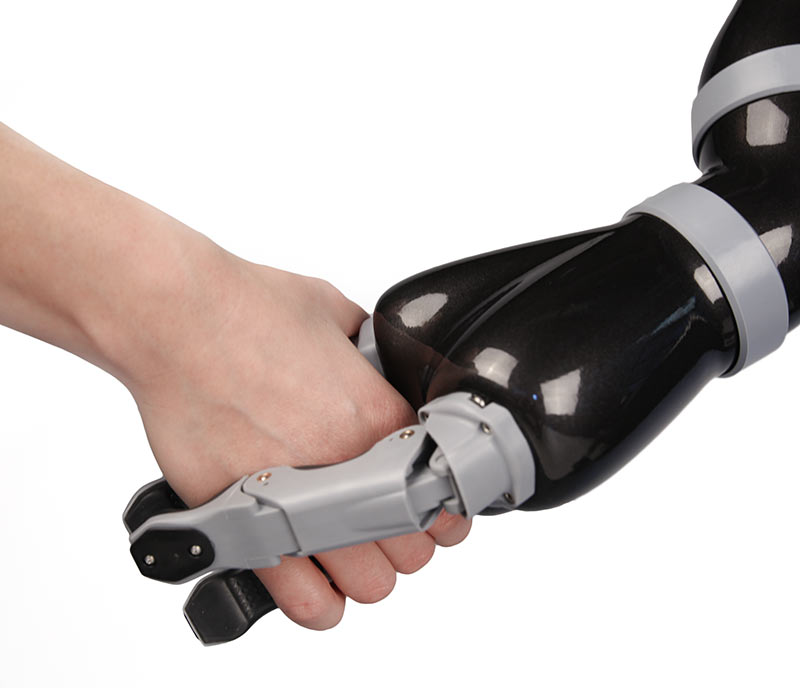Robotic Arm Controlled by Electrical Impulses Can Help SMA Patients Perform Daily Tasks
Written by |

Jaco robotic arm by Kinova Robotics. (Photo courtesy of Kinova Robotics)
The use of a robotic arm controlled by electrical impulses in the arm muscles may increase the independence of paralyzed spinal muscular atrophy (SMA) patients, according to a recent case report.
The case report, “Functional Tasks Performed by People with Severe Muscular Atrophy Using an sEMG Controlled Robotic Manipulator,” was published in IEEE Explore during the 2018 40th Annual International Conference of the IEEE Engineering in Medicine and Biology Society (EMBC).
SMA leads to progressive and symmetrical muscle weakness, which can result in paralysis. Daily activities, such as eating and drinking, become extremely challenging for patients who have lost control of voluntary movements of the limbs, and full-time care is inevitable.
Technological advances have provided some approaches to help patients with limited mobility or total paralysis partially regain their independence. Assisted devices, such as robotic arms, can be controlled by a joystick and through brain computer interfaces (BCI) in patients unable to handle a joystick.
Surface electromyography (sEMG) is a non-invasive procedure that uses electric sensors placed on the skin surface of muscles to detect, record, and interpret the electrical activity of these muscles. Besides its use as a diagnostic tool for neuromuscular diseases, it has been widely used in the field of prosthetics, where recordings of muscular activity are used to control prosthetic hands, arms, and legs, and perform daily tasks.
While the residual electrical activity of people with limited mobility and paralysis, including SMA patients, is not sufficient to exert functional motion of the limbs, it can potentially be used to control a robotic limb.
Ask questions and share your knowledge of SMA in our forums.
Thus, an sEMG-based interface has the potential to be a viable, non-invasive approach to controlling an assistive robotic device and performing daily tasks in paralyzed people with residual electrical muscle impulses.
Researchers at the Institute of Robotics and Mechatronics, German Aerospace Center (DLR), in Oberpfaffenhofen, Germany, have evaluated whether a lightweight robot arm controlled by a sEMG-based interface could help SMA patients perform daily tasks.
The sEMG-based assistive system was tested in two 49-year-old women with SMA type 2 who had almost no voluntary limb movement, but the electric impulses associated with voluntary muscle activation could still be detected by sEMG.
Both had had a previous short contact with sEMG-based interfaces more than two years before this study. One woman had scoliosis due to the disease and preferred to perform all experiments while lying in bed; the other woman sat in a wheelchair.
Eight Delsys Trigno wireless EMG sensors were placed in the right arm of the participants, and the robotic hand-arm — a DLR Light-Weight Robot III (LWR3) equipped with a five-fingered DLR-HIT HAND — represented a right arm.
The performance of the sEMG-based assistive system was evaluated for four consecutive days with two validated assessment tests: a modified version of the Box and Block Test, and parts of the Action Research Arm Test (ARAT).
The Box and Block Test assesses gross manual dexterity of the arm/hand, and in this modified version the women had to grasp five blocks from one box and move them over a 10-centimeter wall into another box. The ARAT assesses upper limb functionality, and of its 19 original items, only nine items of grasp and grip were considered in this study.
The results showed that both participants accomplished reach-and-grasp tasks using the sEMG-based assistive system — some on the first try — showing that they could control the robotic arm-hand in a precise way.
The researchers noted that while the completion of both tasks took substantially longer than that achieved by healthy people or people using a similar system with a prosthetic, performing these tasks with a robotic arm is not easy as no tactile information is being received, and none of the participants received training before the tasks.
They expect that regular training with the system could significantly reduce the completion times of these tasks, but additional long-term studies are required to evaluate the effect of daily training on task performance.
Both women were able to perform a daily task using the robotic system. Each picked up a bottle from a table, moved it close to her mouth, drank from it through a straw, and placed it back on the table.
These data highlight that “paralyzed people with residual voluntary muscle activity can control a robotic hand-arm system via an sEMG-based interface to perform functional tasks,” and that this system can help them to “perform simple activities of daily living without the help of a caregiver,” researchers said.






